The days are getting shorter, which means less light in the mornings. If waking up in the dark is difficult for you and you need some help in the mornings, the answer may be a light alarm.
Rather than terrorising you out of sleep the way your usual alarm clock does, a light alarm will wake you gently, so that by the time you need to get out of bed, you feel ready to face the day.
Also known as a wake-up light or a dawn simulator, light alarms are hybrids of alarm clocks and lamps. They’re designed to wake you slowly with a steady build-up of light that simulates a sunrise, complete with a shift in hue from reds and orange to brighter yellows and white over the course of the wake-up period.
There’s some evidence that light can prepare the body to wake up, signalling the brain to increase your body temperature and raise cortisol levels. This means you shouldn’t wake up as groggy and confused as when you’re jolted from sleep.
Many will also help you to prepare for bed at night by creating a sunset effect that allows your body and brain to relax – and hopefully get a better night’s sleep.
Light alarms can also help SAD sufferers who struggle to get going in the mornings without natural daylight. If you have seasonal affective disorder, you might also like to check out our round-up of the best SAD lights we’ve tested.
We’ve rated and reviewed the best light alarms below but if you need information on the kinds of features you should look out for, read our buying advice after the chart.
Philips SmartSleep – Best overall
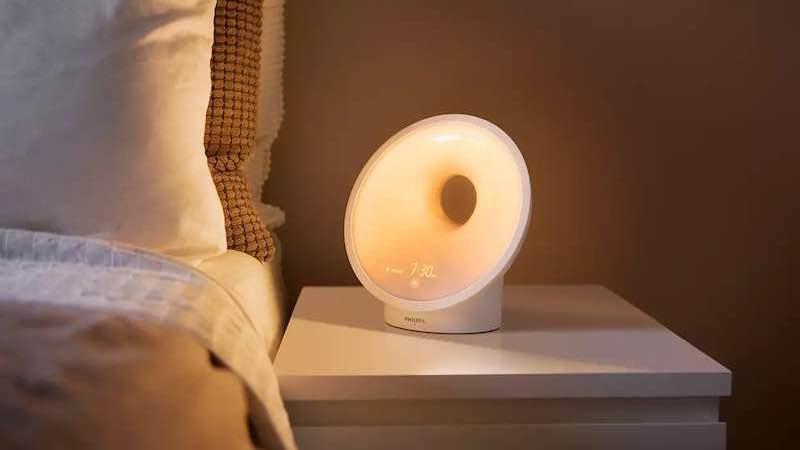
- Pros
- Excellent light alarm
- Touchscreen
- Great features
- Cons
- Price
- Can’t schedule for specific days
This device (previously known as the Somneo) is arguably the best light alarm on the market – that is, if price is not a factor. Still, it’s arguably worth it for the feature set and design.
Instead of physical buttons, there are simple touchscreen controls built into the light itself, which you can use to customise your sunrise and sunset settings, with a range of light intensities, timings, and soothing noises from birdsong to temple gongs.
You can save two different alarm presets. However, you can’t schedule them for specific days, so you’ll have to remember to switch off your weekday alarm when Saturday rolls around.
In addition to a sunset mode, there’s a light-guided breathing mode to help you to fall asleep. Beyond that, there are modern touches throughout: tapping the top to snooze, a dedicated low-intensity light if you wake up in the middle of the night, FM radio, AUX input if you want to fall asleep to sounds from your phone, and even a USB-A slot to charge your phone.
At the end of the day, this is an expensive alarm, with a price tag that not everyone can justify. But if you can, this is about as good as light alarms get.
Lumie Bodyclock Shine 300 – Medically certified for light therapy
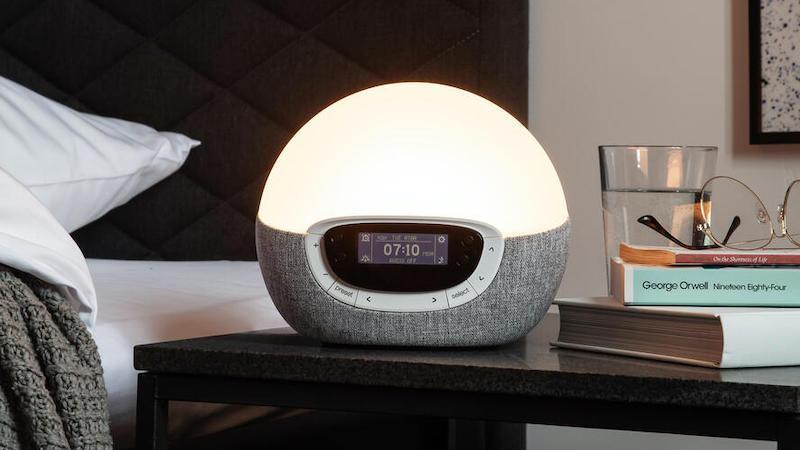
- Pros
- Sounds & light options
- Medically certified
- Cons
- Expensive
- Resets when unplugged
- Fiddly
This alarm is on the more expensive side, but with good reason. The Bodyclock Shine 300 is a fully featured light alarm from Lumie. It offers granular control over your wake up and bedtime routines, with a mixture of sounds and light settings at your disposal.
It has mixed LEDs that shine combinations of white, orange and red to create a realistic sunlight effect that isn’t too blinding and can increase and decrease gradually over 15-90 minutes, at up to 20 different light levels.
While it’s primarily sold as a wake-up alarm, it’s also medically certified for light therapy purposes. If you’ve been diagnosed with SAD, you’ll probably still want a dedicated SAD light box, but a light alarm is a handy complement to it, giving you an energy boost when you might need it the most.
We opted for the maximum brightness scale over 30 minutes and found we woke up naturally. However, you can set the alarm at the end of that time period if you don’t trust you’ll wake up using the light alone.
The alarm can be set to beep or use one of the preset sounds including a stream train (unusual), ping pong (also odd), waves (more conventional), or the inbuilt FM radio.
Annoyingly, if you turn it off at the mains all the settings reset to factory, and the buttons on the unit mean it’s fiddly to set up. However, once it’s up and running, it’s an excellent product.
Lenovo Smart Clock – With Google Assistant
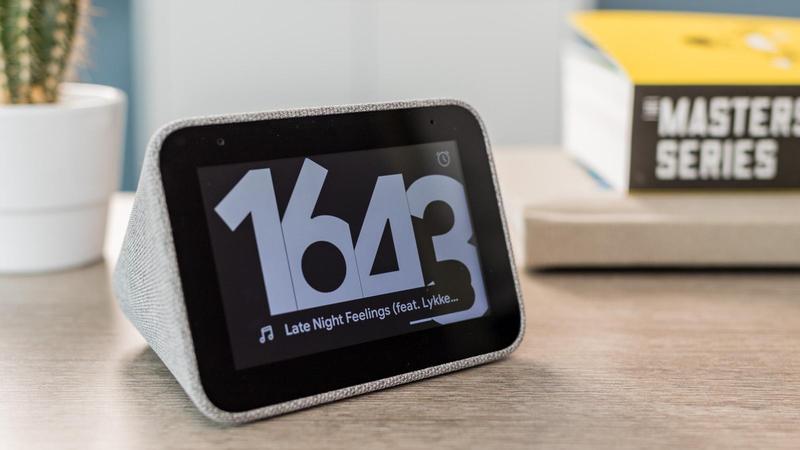
- Pros
- Full smart display functionality
- Cons
- Not a dedicated light alarm
The Lenovo Smart Clock isn’t a light alarm first and foremost, it’s a mini smart display, powered by Google Assistant.
Still, it does also function as a rudimentary light alarm, slowly brightening the screen itself before the alarm goes off. It’s not as bright as the other alarms in this list, and has less variation in tone, so the light alone is unlikely to wake you up entirely, but it does help.
Still, it means you get all the other features of Google Assistant – voice controls, calendar, checking the weather, listening to music, and more. This is basically a Google Home Mini with a screen, so there’s a huge amount of functionality that none of the dedicated light alarms on the market right now can match.
Read our full Lenovo Smart Clock review
Lumie Zest SAD & wake-up light – Dual functionality
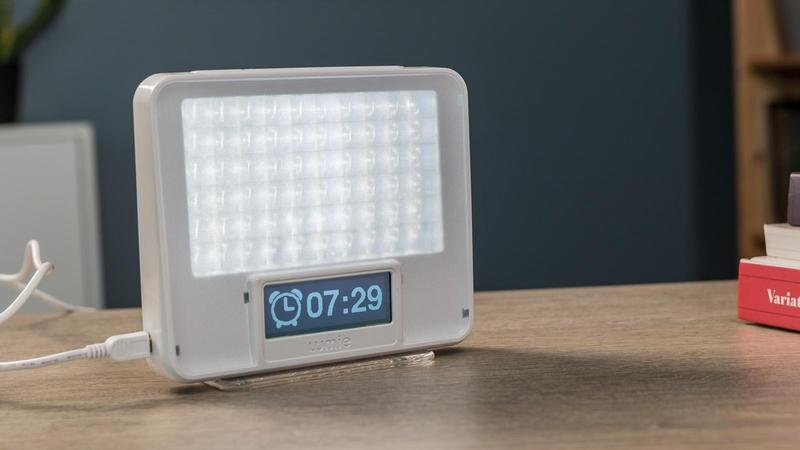
- Pros
- SAD light
- Class IIa medical device
- Cons
- Limited features
- Must be plugged in all the time
The Lumie Zest has dual functionality. It’s both a light alarm and a SAD lamp and is rated as a Class IIa medical device.
The wake-up light has two sunrise options (15 or 30 minutes), along with a snooze function. The blue-enriched white LEDs simulate natural daylight, waking you up gently. You can set a beeping alarm if you want, but you can’t choose any other audio options as you can on dedicated wake-up lights. (Bear in mind that the beeping alarm isn’t particularly soothing.)
For light therapy, you can choose brightness (up to 10,000 lux) and timer settings. The adjustable stand makes it easy to position it towards your face for the greatest effect.
It does need to be plugged in all the time, but because it’s so compact, you can move it around your home easily to use its SAD lamp functionality.
If you’re willing to forgo some of the light alarm features a dedicated product will have, the ability to double up as a SAD lamp makes this a great hybrid option for someone who wants to try out different forms of light therapy.
Groov-e Light Curve Wake-Up Light Alarm Clock with Radio – Best budget option
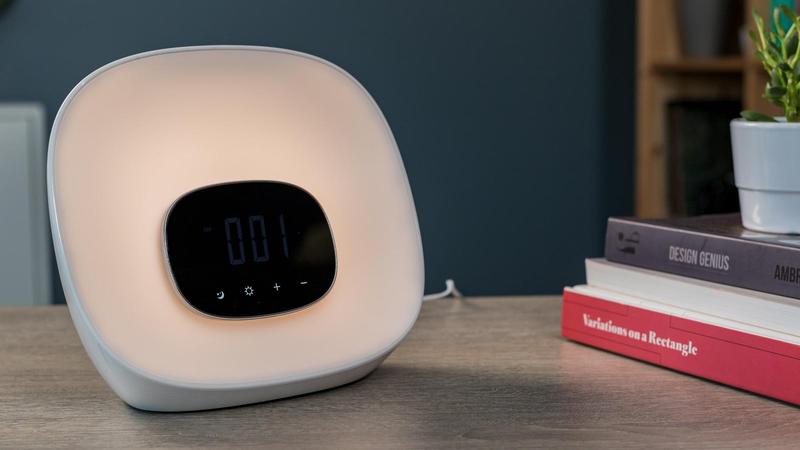
- Pros
- Budget-friendly
- Mood light feature
- FM radio
- Cons
- No nature sounds
- Less bright than competitors
Looking for a light alarm that won’t break the bank? The Light Curve Wake-up Light from Groov-e fills that niche, with a few nifty extra touches. You can use both sunset and sunrise options to decrease/increase your light’s brightness over ten settings over a period of either 10, 20 or 30 minutes. However, the shift between the brightness levels is not as smooth as those from more expensive rivals.
With the sunrise option, you can also add audio effects, choosing between FM radio or one of the programmed sounds on the light. Most of these are musical. Unfortunately, there are no nature or ambient sounds, which are available on other lamps.
This budget light alarm also doubles up as a mood light, with seven colours that rotate – or the option to set it to your preferred shade. None of its rivals offer this feature, so although the Groov-e is missing some functionality, this is an unusual selling point.
The light itself isn’t as bright as competing products, but it’s enough to produce a decent glow. All in all, if you’re looking for a budget light alarm and don’t mind a few compromises, this is a great option.
Amazon Echo Show 5 – With Alexa functionality
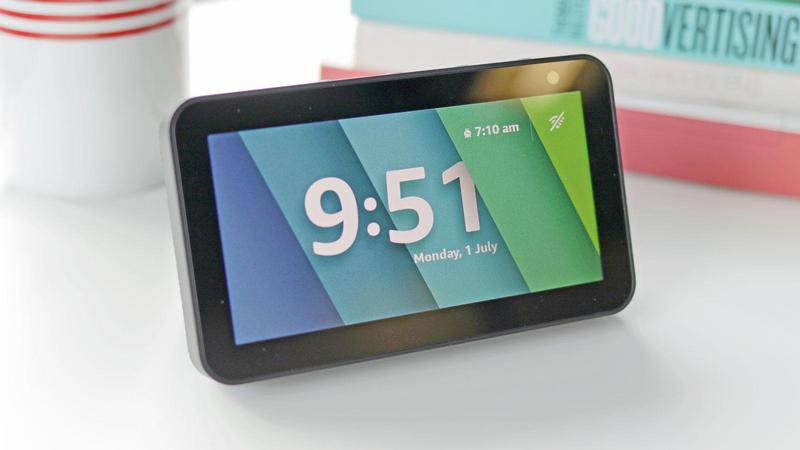
- Pros
- Full smart assistant functionality
- Cons
The Echo Show 5 is not a dedicated light alarm. But its sunrise effect increases brightness to wake you gently. It starts 15 minutes before your alarm time (although that’s restricted to alarms between 4am and 9am).
This function works alongside alarm tones which can be set gradually to increase in volume. The Echo Show 5 isn’t as bright as a specialised light alarm because it’s really just a 5.5in LCD screen. So, it may not be as effective if you’re a deep sleeper.
But it offers similar advantages: it has the inbuilt functionality of Alexa. The interface has been updated, too, to make it easier to access and control your smart home devices, although you can also use voice commands.
The speaker is good enough for listening to music in the bedroom and it has Bluetooth, so you can stream music from your phone.
And if you’re worried about the inbuilt camera, a slider on top lets you cover it up for privacy.
Read our full Amazon Echo Show 5 review
Lumie Bodyclock Luxe 700FM – Add custom wake-up audio
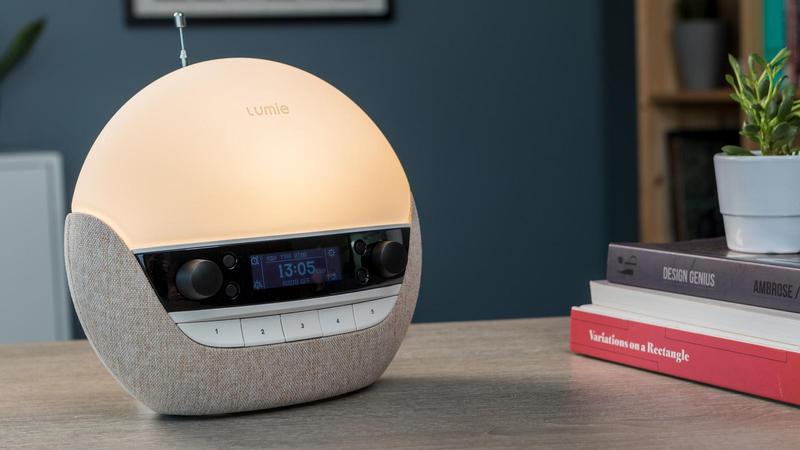
- Pros
- Over 20 sounds
- Bluetooth speaker
- Customised scheduling
- Cons
- You’re paying extra for the speaker
Towards the top end of the light alarm range is the Bodyclock Luxe, which comes with FM radio, Bluetooth speakers, over 20 sounds, sunset and sunrise settings and a low blue light feature for the evenings.
Setting the alarm is relatively easy, and you can customise different times for different days. The duration of each sunrise and sunset mode can be adjusted, and you can choose from a range of natural sounds and ambient noise to create the atmosphere you want – one of which includes café noise, if a café breakfast is your sort of thing.
The actual light is extremely warm and mimics the sunset range very well thanks to its combination of coloured LEDs (low-blue white, blue-enriched white, orange and red). You can also keep the lamp on very low as a night light.
The Bluetooth speaker allows you to add custom sounds to wake you up, but it’s also the main factor in boosting the price of the Bodyclock Luxe. It’s great to have a product that boasts an extra feature, but there are other, extremely similar Lumie light alarms that are much more budget-friendly. If a Bluetooth speaker isn’t a dealbreaker, we’d consider something like the Bodyclock Shine.
Lumie Bodyclock Spark 100 – Best budget Lumie option
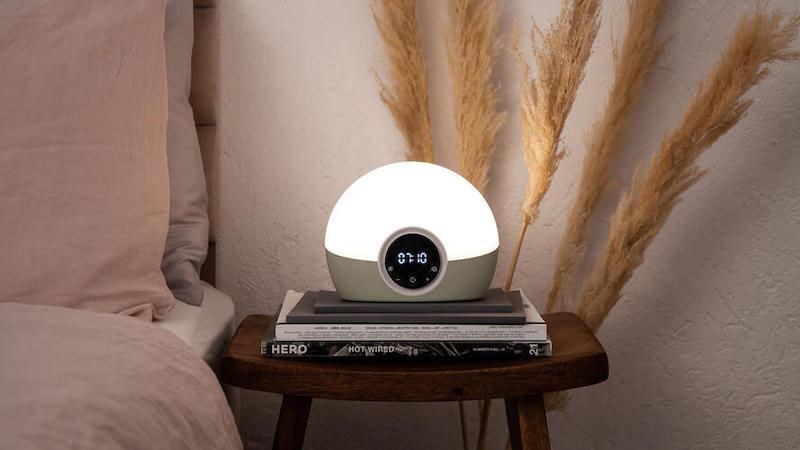
- Pros
- Customisable light intensity
- Cons
- Limited audio
- Limited scheduling
If you like the sound of the Shine 300 but want a more budget-friendly option, you might want to consider the Spark 100, a cheaper model in the same Bodyclock range.
You can use it either as a light alarm to wake up or with a sunset mode to go to sleep, with customisable light intensity over the 30-minute modes.
Unlike the Shine 300, you can’t change the duration of either the sunrise or sunset period, and the audio options are also more limited: the only wake-up option is a beep, with none of the soothing waves or FM radio options available from rival products.
The more annoying omission is the inability to set an alarm schedule. While you can save a default time, you’ll still need to remember to turn the alarm on every night before you go to sleep, which is a slight flaw in an otherwise excellent product.
Philips Wake-up Light – Best design
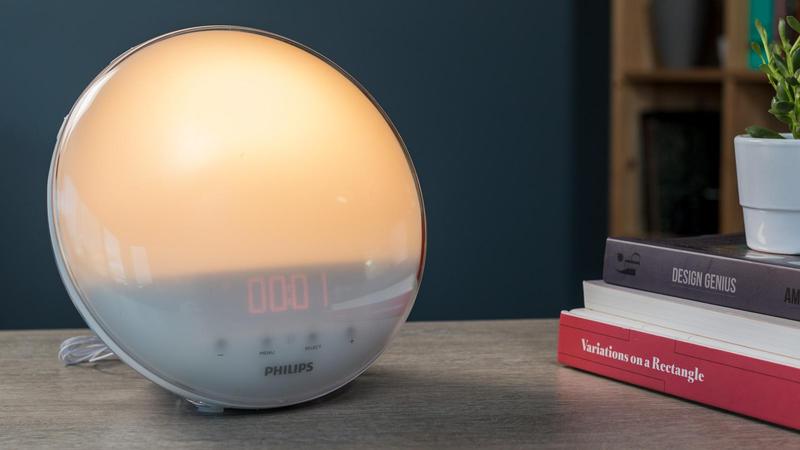
- Pros
- Great to look at
- FM radio & natural sounds
- Cons
- Learning curve to get it set up
The Philips Wake-up Light is one of the most aesthetically-pleasing lamps around, with a large bright face that changes naturally through a display of warm colours, ranging from red to bright yellow.
Like most of its rivals, this lamp comes with FM radio and a list of natural sounds to wake you up. However, there are only seven options available, so it doesn’t have as much choice as rivals (and one of the options is a group of cows mooing, which is somewhat bizarre).
If you wake up in the night and need to find your way around, you can tap the lamp twice to activate the midnight light function, which is an unobtrusive orange glow that won’t disturb your sleep cycle. The display brightness is also self-adjusting, so if your room is dark, the lamp will change to suit the atmosphere.
This wasn’t the most straightforward lamp to use. I had issues trying to stop the radio from turning on automatically whenever I set the lamp to the sunset cycle. After a few days with the product, I managed to get to grips with it, but there are more user-friendly lamps out there at around the same price point.
Light alarm buying advice
There are a few key features to look out for in a light alarm.
Light settings
The first thing to check is how much…
